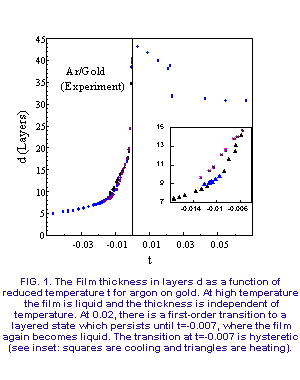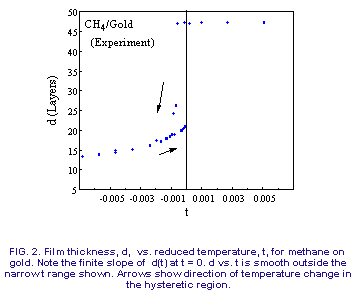Abstract
Introduction
Experimental Setup
Data
Discussion
Results
References
|
 |
Data
 The primary data of our experiment
consist of the frequency shift of the microbalance as a function of temperature;
data for Ar and CH4 are shown in Figures 1 and 2 where the frequency shift
has been converted to thickness in layers. Data were collected by changing
the temperature of the cell by approximately 20mK and waiting for the microbalance
frequency to settle. As has been noted previously [8], we found that the
time constant for mass transport in the cell was surprisingly long, and
more than 24 hours of settling time was typically required per data point. The primary data of our experiment
consist of the frequency shift of the microbalance as a function of temperature;
data for Ar and CH4 are shown in Figures 1 and 2 where the frequency shift
has been converted to thickness in layers. Data were collected by changing
the temperature of the cell by approximately 20mK and waiting for the microbalance
frequency to settle. As has been noted previously [8], we found that the
time constant for mass transport in the cell was surprisingly long, and
more than 24 hours of settling time was typically required per data point.
 Figure 1 shows data for
Ar as a function of t. For t>0.02, corresponding to temperatures more
than 1.6K above the triple temperature (~ 83.31 K), there are approximately
32 layers of adsorbed liquid; Figure 1 shows data for
Ar as a function of t. For t>0.02, corresponding to temperatures more
than 1.6K above the triple temperature (~ 83.31 K), there are approximately
32 layers of adsorbed liquid;  this
value is determined by the competition between van der Waals forces which
tend to thicken the film, and gravity, which tends to thin it. At low temperatures,
e.g. t=-0.06, or 5 K below Tt, the film is approximately 5 layers
thick. As can be seen in Fig. 1 the transition from the thick high temperature
state to the thin low temperature film is not a smooth function of temperature.
There are two significant temperatures in addition to Tt: at
t=- 0.007 there is a small hysteretic step and a change in slope and at
t=0.02 there is a discontinuity. The thermodynamic model discussed below
identifies the region -0.007<t<0.02 as a layered phase with solid
adjacent to the substrate and a liquid layer on top. At both boundaries
of this region, there is a first order transition to a film which is entirely
liquid. At high temperatures, the film is a wetting liquid film with a
thickness that is essentially independent of temperature, while at low
temperature, the liquid film thickness has a power law dependence on -t
with an exponent of -0.38. The layered film thickness for -0.007<t<0
obeys a power law dependence on -t with an exponent of -0.28. this
value is determined by the competition between van der Waals forces which
tend to thicken the film, and gravity, which tends to thin it. At low temperatures,
e.g. t=-0.06, or 5 K below Tt, the film is approximately 5 layers
thick. As can be seen in Fig. 1 the transition from the thick high temperature
state to the thin low temperature film is not a smooth function of temperature.
There are two significant temperatures in addition to Tt: at
t=- 0.007 there is a small hysteretic step and a change in slope and at
t=0.02 there is a discontinuity. The thermodynamic model discussed below
identifies the region -0.007<t<0.02 as a layered phase with solid
adjacent to the substrate and a liquid layer on top. At both boundaries
of this region, there is a first order transition to a film which is entirely
liquid. At high temperatures, the film is a wetting liquid film with a
thickness that is essentially independent of temperature, while at low
temperature, the liquid film thickness has a power law dependence on -t
with an exponent of -0.38. The layered film thickness for -0.007<t<0
obeys a power law dependence on -t with an exponent of -0.28.
  Figure
2 shows that the temperature dependence of the film thickness for CH4
is distinctly different from Ar. Above Tt (~ 90.68 K) the film has a constant
temperature independent thickness of approximately 47 layers and shows
no evidence of any phase transitions. At the triple point, the film thickness
abruptly thins to 21 layers. It is noteworthy that in CH4 both
the bulk phase transition and the film thinning are hysteretic with a width
of approximately 0.10 K, while in Ar the hysteresis in the bulk transition
was undetectable. For CH4, below Tt, the film thickness
is a smooth slowly varying function of t having a finite slope at t = 0. Figure
2 shows that the temperature dependence of the film thickness for CH4
is distinctly different from Ar. Above Tt (~ 90.68 K) the film has a constant
temperature independent thickness of approximately 47 layers and shows
no evidence of any phase transitions. At the triple point, the film thickness
abruptly thins to 21 layers. It is noteworthy that in CH4 both
the bulk phase transition and the film thinning are hysteretic with a width
of approximately 0.10 K, while in Ar the hysteresis in the bulk transition
was undetectable. For CH4, below Tt, the film thickness
is a smooth slowly varying function of t having a finite slope at t = 0.
|
|

